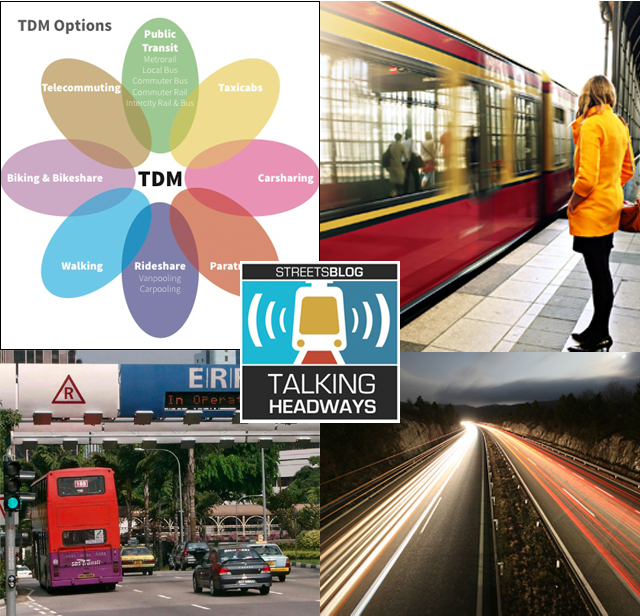This week we’re joined by Tien-Tien Chan of Nelson Nygaard and Jessica Roberts of Alta Planning and Design to talk about Transportation Demand Management. Chan and Roberts discuss how TDM acts as the soft side of transportation and the flipside of infrastructure and they dive deep into the different types of programs are employed.
For those of you who prefer to read rather than listen, a full unedited transcript (with some typos!) is here. If you want an edited transcript, read the copy below the player:
Jeff Wood: I’m curious what the negative externalities are that Transportation Demand Management is trying to solve — and what are the main opposition for planners?
Tien-Tien Chan: Historically, I feel like recent history TDM has been so focused on reducing vehicle miles traveled and reducing vehicle trips and seeing that quantitative mode shift from single occupancy vehicles. And that discussion and language and source of motivation is evolving a lot over the past few years. How are we reducing mobility barriers? How are we improving mobility access? How are we creating safe community space through transportation demand management? That's more holistic rather than just very simply VMT, VT, SOV, all those fun acronyms.
Jessica Roberts: What I’m kind of thinking of right now is about places where the automobile is kind of the only choice that gets you where you’re going in a reasonable amount of time and offers you the type of flexibility and independence that you need to live your life. And places where you have to drive a car are really impoverished places from so many perspectives. (I fact-checked this because I’ve been saying it for years and every time I’m like, could I back that up?)
I’m sure you’ve all heard that 30 percent of Americans can’t or do not drive. And that’s a lot of people. How could we ethically as a society, or how could governments, say one in three people aren’t important if they can’t get around by car — that’s too bad for them? That’s simply too many people to ignore. But our policy is written as if those people do not exist or do not matter. And if you ask people, "How many people don’t drive?" They’d say, "Oh, I dunno, maybe like 5 percent." So, you know, places where everyone feels they have to drive or where we have sort of forced their hand through the built environment and through what behavioral scientists would call the choice architecture or the choice environment that really makes driving the dominant choice.
You know, there are places where people can’t get to know their neighbors as easily. Obviously there are places where the world outside isn’t as healthy children are more likely to get asthma. Children are more likely to, you know, suffer cognitive impairments because of poor air quality. There are places where seniors, people with any kind of mobility impairment, young people, they just can’t live as rich a lives. They simply have to stay home more. Poor people don’t have access to as many job opportunities. You or someone you care about is more likely to get hurt or killed by a car. These are quality-of-life outcomes that I think we should find unacceptable as a society. And the fact that we can’t really see them and evaluate them and decide for ourselves, whether that’s okay is, is I think a real failure of, you know, imagination and perspective taking.
Tien-Tien Chan: Man, what a downer Jessica.
Jessica Roberts: I’m saying, that’s why our work matters so that we can have another path forward.
Tien-Tien Chan: Yeah, exactly. If I think about what our call to action in the TDM space, Jessica, you alluded to this in your definition of TDM, that we are the flip side of infrastructure, the soft side of transportation. And I feel like TDM has the opportunity to really fill a lot of near-term gaps where we, for example, know we need better public transit in a lot of different places, but that takes a lot of time. We know zoning code needs to be overhauled and that all takes time.
In the long term, it is about complementing really thoughtful infrastructure, complementing really thoughtful design, safe design of our streets and adding to that and making sure that it is working in tandem. I also think this is like a much bigger conversation, but thinking about transportation demand management as not just solving for mode split, but creating the safe community space from a softer side and not creating a safe community space from just an infrastructure, traffic calming perspective, right?
Like TDM plays such an important role to work with the community immediately.
Jessica Roberts: Tien-Tien, you’re totally my hype woman because this is, you know, this is essentially what I tell people about the work that I do. I always say everything my colleagues do is heading towards the ribbon-cutting, and intends to transform the built environment. And that’s really, really important. A behavior change campaign cannot succeed when the built environment, the policy environment, the pricing environment are all working against you. But it takes a long time to do that work. I can have a campaign done in a year. You know, we have some really good metrics on some of what we do. So yeah, I think they can work together, right? Like the sort of campaign, the person-to-person approach that kind of like, you know, lighter, more nimble wraparound approach.
It can serve as an advanced scout for the policy pricing and infrastructure work. It can support it once it’s being rolled out to amp up the return on investment. And after that work is done and the funding is complete, it can continue to get that long tail of impact over time.






